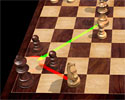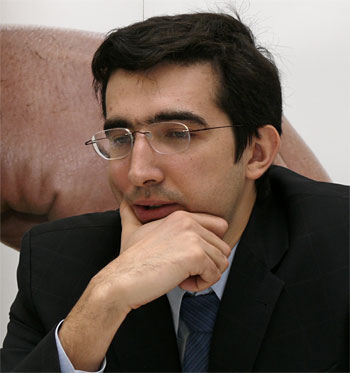


 The
chess duel Man vs Machine, Vladimir Kramnik vs Deep Fritz is being staged from
November 25 until December 5th. It is sponsored by the RAG
AG, one of Europe's largest energy companies. The venue is the National
Art Gallery in Bonn, Germany. Schedule:
The
chess duel Man vs Machine, Vladimir Kramnik vs Deep Fritz is being staged from
November 25 until December 5th. It is sponsored by the RAG
AG, one of Europe's largest energy companies. The venue is the National
Art Gallery in Bonn, Germany. Schedule:
| Game 1: | Saturday | 25.11.2006 | 15:00 h |
| Game 2: | Monday | 27.11.2006 | 15:00 h |
| Game 3: | Wednesday | 29.11.2006 | 15:00 h |
| Game 4: | Friday | 01.12.2006 | 15:00 h |
| Game 5: | Sunday | 03.12.2006 | 15:00 h |
| Game 6: | Tuesday | 05.12.2006 | 15:00 h |
There is full live coverage on the Playchess server, as well as on the official site and a number of partner sites.
Before we try to explain how the blunder of the century could happen, here for all of you who have been out of touch with chess is the fateful game, the second of the match and one that is going to haunt the dreams of the world champion for a long time to come.
Deep Fritz 10 - Kramnik,V (2750) [D10]
Man vs Machine Bonn, Germany (2), 27.11.2006
1.d4 d5 2.c4 dxc4 3.e4 b5 4.a4 c6 5.Nc3 b4 6.Na2 Nf6 7.e5 Nd5 8.Bxc4
e6 9.Nf3 a5 10.Bg5 Qb6 11.Nc1 Ba6 12.Qe2 h6 13.Be3 Bxc4 14.Qxc4 Nd7 15.Nb3
Be7 16.Rc1 0-0 17.0-0 Rfc8 18.Qe2 c5 19.Nfd2 Qc6 20.Qh5 Qxa4 21.Nxc5 Nxc5 22.dxc5
Nxe3 23.fxe3 Bxc5 24.Qxf7+ Kh8 25.Qf3 Rf8 26.Qe4 Qd7 27.Nb3 Bb6 28.Rfd1 Qf7
29.Rf1 Qa7 30.Rxf8+ Rxf8 31.Nd4 a4 32.Nxe6 Bxe3+ 33.Kh1 Bxc1 34.Nxf8.
Now 34...Kg8 35.Ng6 Bxb2 36.Qd5+ Kh7 37.Nf8+ Kh8 38.Ng6+ is the forced draw.
But Kramnik played 34...Qe3?? The blunder of the century.

35.Qh7# 1-0. [Click to replay]
As we mentioned in an earlier report Kramnik played the move 34...Qe3 calmly, stood up, picked up his cup and was about to leave the stage to go to his rest room. At least one audio commentator also noticed nothing, while Fritz operator Mathias Feist kept glancing from the board to the screen and back, hardly able to believe that he had input the correct move. Fritz was displaying mate in one, and when Mathias executed it on the board Kramnik briefly grasped his forehead, took a seat to sign the score sheet and left for the press conference, which he dutifully attended.

Fritz operator Mathias at the end of the game
In the post match press conference Vladimir Kramnik confirmed that he had not blundered out of exhaustion, and had been calculating very well right to the end. He had no real explanation for the oversight that happened right at the end.

The press conference minutes after the game, with Vladimir Kramnik, match
organiser Joseph Resch, and Fritz operator Mathias Feist

Kramnik still quite dazed by the sudden end of the game
Kramnik in the press conference: "It was actually not only about the last move. I was calculating this line very long in advance, and then recalculating. It was very strange, some kind of blackout. I was feeling well, I was playing well, I think I was pretty much better. I calculated the line many, many times, rechecking myself. I already calculated this line when I played 29...Qa7, and after each move I was recalculating, again, and again, and finally I blundered mate in one. Actually it was the first time that it happened to me, and I cannot really find any explanation. I was not feeling tired, I think I was calculating well during the whole game... It's just very strange, I cannot explain it."

Thus the question that everyone was asking remained unanswered: how can a player of Kramnik's caliber, a world champion who hovers around the Elo 2800 mark, overlook a mate in one move? Naturally there is no logical explanation – we have to delve into the realm of pattern recognition and the psychology of human perception if we want to understand anything.
Let us at least try to imagine what when through Kramniks head, and through his eyes and optical nerves, in the critical position. We will use the spectacular new 3D graphics of Deep Fritz 10, the program Vladimir is playing against, to illustrate what we are saying.
The above picture (click to enlarge) shows is what Vladimir was concentrating on. He had probably seen that after 34...Kg8 Deep Fritz had a forced draw (34...Kg8 35.Ng6 Bxb2 36.Qd5+ Kh7 37.Nf8+ Kh8 38.Ng6+), and so his mind was concentrated on the two wonderful pawns on the queenside which, were it not for the white queen on e4, would simply advance and queen on a8, winning the game.

Vladimir Kramnik pondering the position before his 34th move in game two.
How to deflect the queen? Well, why not offer a queen trade with ...Qe3. If White takes on e3 Black has an easy win, e.g. 34...Qe3 35.Qxe3 Bxe3 36.Ng6+ Kh7 37.Nf8+ Kg8 38.Nd7 a3 39.bxa3 bxa3 40.g3 a2 41.Kg2 a1Q 1-0. And if the white queen moves away Black still has very powerful winning lines, e.g. 35.Qxb4 Qe2 36.Qb6 Be3 and White can resign.
So things were looking great for the world champion, who was probably checking lines we discussed above, and others as well, most involving the black pawns on a4 and b4. In the picture above you can see his eyes are on the queenside.
Unfortunately, Kramnik had somehow not registered the threat generated by the Fritz move 34.Nxf8. The white queen threatens mate in one on h7 (where it is protected by the knight). Black does nothing to neutralise this threat with his move 34...Qe3. And so, after he played it, Kramnik was immediately mated by the computer.
But how could he not have seen the threat after 34.Nxf8. An explanation was proffered by a very experienced chess player and trainer, Alexander Roshal, who is also the editor of the Russian chess magazine "64".

Alexander told us that the mating pattern that occurred during the game, with the white queen protected by a knight on f8 (as in the screen shot above), is extremely rare in chess. It is not one of the patterns that chess grandmasters automatically have in their repertoire. This was confirmed by a GM commentator in Bonn, who after Kramnik's move did not notice that it was a blunder and started discussing White's options – but not the mate in one.


Alexander Roshal assured us that, had the white knight somehow moved to g5 or f6, as in the above Fritz 10 screen shots, Kramnik would have seen the mate in micro-seconds. The square h7 would have had a big red light blinking on it, Roshal said, because this kind of mate (or mating threat) occurs quite often in chess, and the mating pattern would be firmly anchored in his mind. With the knight in an unsual position the square remained dark and Kramnik simply did not see the danger.